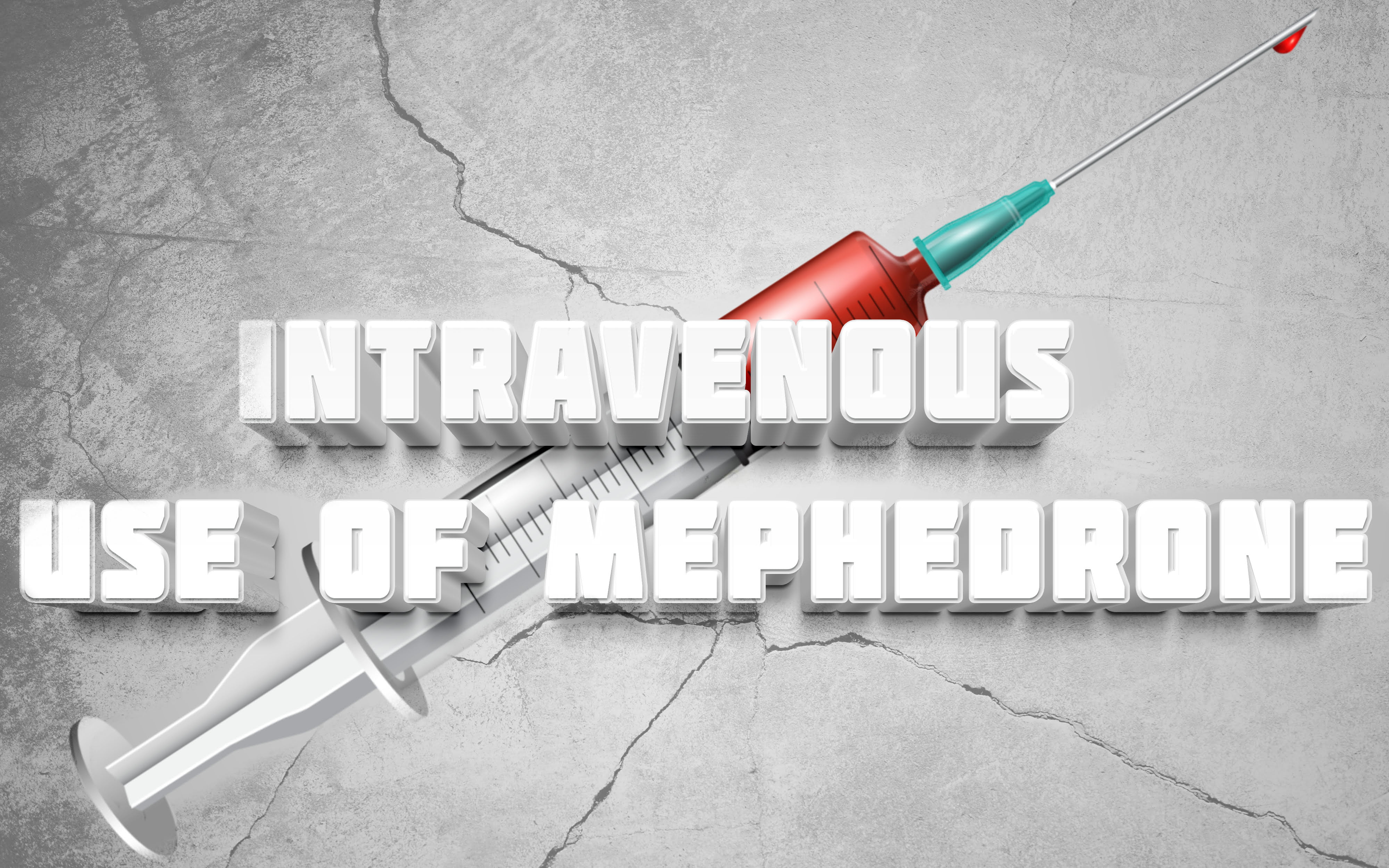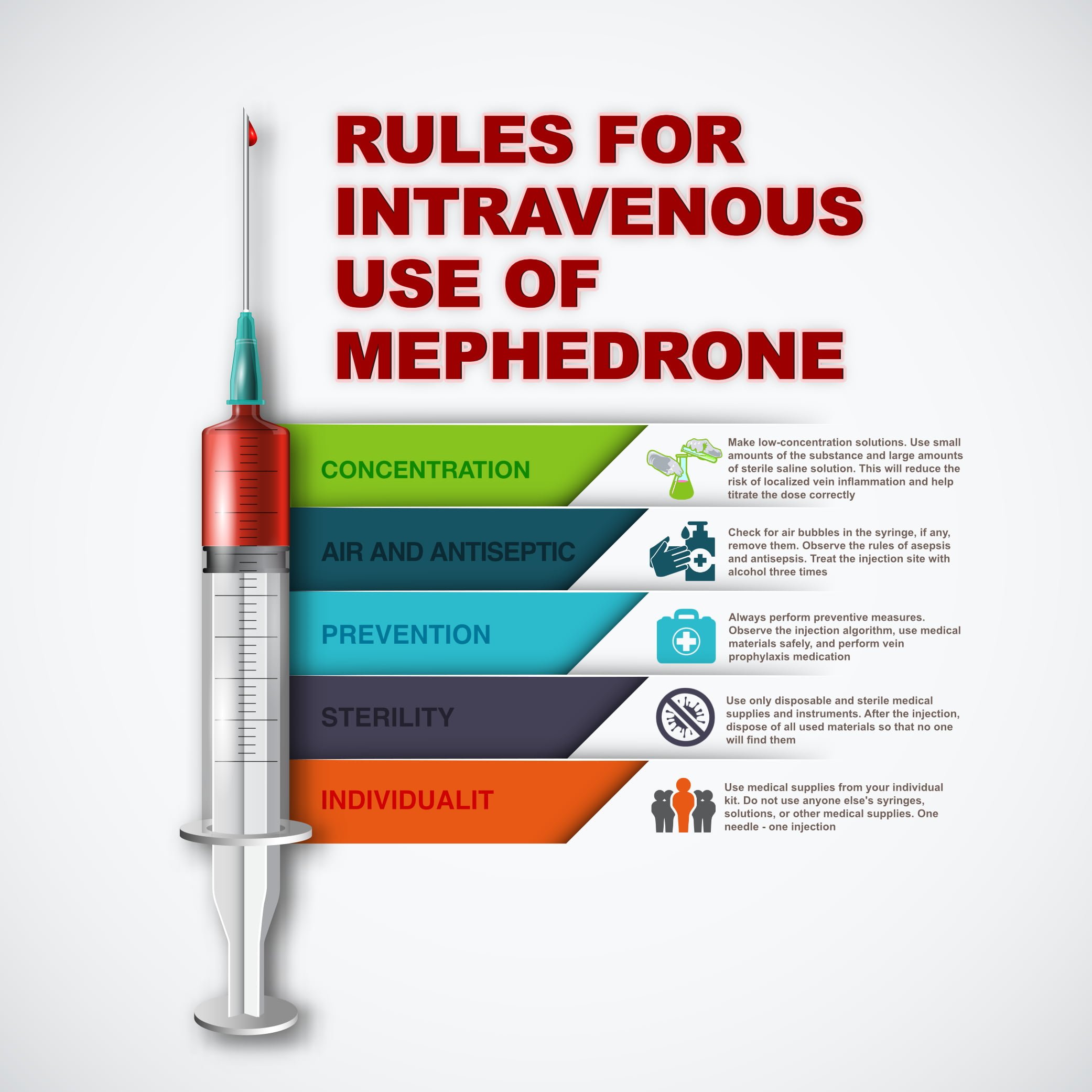Mephedrone, a synthetic stimulant belonging to the cathinone class, has gained popularity as a recreational drug due to its euphoric and stimulating effects. Intravenous administration, while offering rapid onset and heightened intensity, carries inherent risks and potential complications. This article outlines the essential safety rules and best practices for intravenous mephedrone use, emphasizing harm reduction and vein preservation.
Intravenous administration of a substance requires compliance with strict rules of asepsis and antiseptics, a certain skill in the technique of manipulation, as well as knowledge of possible complications and the ability to quickly provide the necessary appropriate assistance in case of their occurrence.
Various complications often occur during an intravenous injection, the most common of which are:
-
Soft tissue diseases – getting the solution with the substance into the subcutaneous fatty tissue due to the needle passing through the vein (forming infiltrates or hematomas, abscesses or phlegmon)
-
Thrombophlebitis
-
Chemical – occurs when injecting synthetic psychostimulants; chemical damage to the vein in this case occurs almost always, but the clinical manifestation of phlebitis may be latent and spontaneously disappear
-
Infectious phlebitis – occurs due to the entry of an infectious agent;
-
Mechanical phlebitis – occurs due to extensive trauma to the vein as a consequence of repeated needle damage.
-
Venous embolisms
-
Venous thrombosis
-
Infection with viral hepatitis – occurs when an infected body fluid comes into contact with human blood or mucous membranes. This happens when the same set of medical supplies is used by different people.
-
Nerve damage – when the end of the needle enters the nerve, there is a disturbance of sensitivity and spasm of the vein.
Prepare
Checking the substance
-
Rule 1 – Use special reagents for MCAT testing. This is a set of solvents that you can drop on a small sample and the resulting color change will help you identify the substance. For example, you can purchase a similar kit here protestkit.eu/product/mephedrone-reagent-test-kit, and you can see the benchmark results in the table below.
-
Rule 2 – Estimate what fraction of mephedrone you have in front of you to get the dose right. Read more about mephedrone fractions here – https://mephedrone.com/guide/how-to-distinguish-pure-mephedrone-from-poorly-cooked-one
-
Rule 3 – Absolutely always use an algorithm to purify mephedrone of unknown toxic and potentially dangerous substances. Purification is the best chemical way to minimize the risks of mephedrone use. Read more about mephedrone purification here – https://mephedrone.com/guide/strong-home-mephedrone-4-mmc-recrystallization-strong.
Medical supplies
Before administering an intravenous injection, medical supplies must be prepared:
-
Two 2 ml disposable syringes (do not use insulin syringes or large-volume syringes; one syringe is used for solution preparation and filtration, and the other syringe and needle is used for intravenous injection)
-
Disposable sterile solution preparation container
-
Alcohol wipes
-
Sterile solution of water for injection or 0.9% saline sodium chloride solution
-
Rubber tourniquet
-
Sterile material for filtration.
Hygiene and Sterilization
Prior to injection, ensure that the injection site, equipment, and hands are thoroughly cleaned. Use an alcohol swab to disinfect the skin and allow it to air dry. Sterilize all equipment, including needles, syringes, and filters, to minimize the risk of infection.
Dosage and Dilution
Accurate dosing is crucial to prevent overdose and adverse reactions. Consult reliable sources for appropriate dosage guidelines and always start with a lower dose to gauge individual tolerance. Dilute mephedrone in sterile water to reduce the concentration and minimize vein irritation. A high dilution titer is recommended. The lower the solution concentration, the safer the trip and the lower the risk of complications.
Remember – high solution concentrations severely damage vein walls. This leads to bad consequences (development of an infiltrate, post-injection abscess or phlebitis). If the concentration of the solution is high, the blood clots strongly and prevents normal injection of the substance.
The doses of mephedrone for intravenous injection are as follows:
-
Low – 0.15 mg/kg;
-
Medium – 0.15-0.25 mg/kg;
-
High – more than 0.25 mg/kg.
These doses are only valid for the pure substance. As a general rule, the mephedrone doses used are 20-30% higher than those given in our recommendations. It depends on the quality of the product, the presence of tolerance to the substance, and other factors. After 3-4 times of using mephedrone in one session, there is no point in using it again, because the tolerance will be high and the “expected” effects and their duration will be minimal.
If you are using in company – it is strictly forbidden to use shared syringes, filters, vials with solution. After the use of medical supplies, they must be disposed of in a place that will be inaccessible and safe. It is categorically not recommended to inject a needle into damaged skin or vein. Look for injection sites where there is no skin damage.
Intravenous Mephedrone Use – Injection Technique
Vein Selection
Choose a suitable vein for injection, preferably in the forearm or the antecubital fossa. Avoid injecting into smaller, superficial veins or those with a history of damage or thrombosis. Rotate injection sites to prevent overuse and allow for proper healing.
To identify a vein, a number of parameters must be considered: visually visible, protruding above the skin surface and contoured, remaining in the same place when pulled back and not dislocated.
Needle Insertion
Use a new, sterile needle for each injection and insert it at a 30-degree angle to the skin, with the bevel facing up. Advance the needle slowly and gently into the vein, taking care not to puncture the opposite wall.
Once the needle is in the vein, gently pull back on the plunger to aspirate blood, confirming proper placement. Slowly inject the mephedrone solution, taking care not to apply excessive pressure, which may cause vein rupture or extravasation.
Post-injection Care
Needle Removal and Hemostasis
After completing the injection, promptly remove the needle and apply gentle pressure to the site with a sterile gauze pad to achieve hemostasis. Avoid vigorous rubbing, which may cause bruising or hematoma formation.
Wound Care
Clean the injection site with an antiseptic solution and cover it with a sterile adhesive bandage to prevent infection. Monitor the site for signs of inflammation, infection, or thrombosis, and seek medical attention if necessary.
Safe Disposal
Properly dispose of used needles and other sharps in a puncture-resistant container to prevent needlestick injuries and the spread of bloodborne pathogens.
Important algorithms
To make it easy to remember the basic criteria for a successful injection, you need to remember the word CAPSID, which stands for the following:
С – Concentration – it is necessary to create weakly concentrated solutions. Use a small amount of the substance and a large amount of water for injection. This reduces the risk of vein damage and also helps titrate doses to reduce side effects.
A – Air and Antiseptic – check for air bubbles in the syringe with the solution; if there are any, remove them. Be sure to follow the rules of antisepsis, use alcohol to treat the skin.
P – Prevention – perform preventive measures aimed at improving the condition of the veins. Prophylaxis includes adherence to the injection algorithm, safe use of all medical supplies, and medication support for vein condition.
S – Sterility – use only disposable and sterile medical supplies for intravenous injections.
I – Individuality – use only an individual set of medical supplies. Do not use the same instruments and needles for the entire company. The main rule: one needle – one injection!
D – Disposal – properly dispose of used needles and other sharps in a puncture-resistant container to prevent needlestick injuries and the spread of bloodborne pathogens. Dispose of medical supplies in a way that no one will find them.
Seek medical help:
-
Fever up to 39°C or prolonged fever
-
Disturbance of consciousness to the point of coma, delirium
-
Hallucinations with psychosis,
-
Severe pain and redness at the needle site (persists for >6 hours)
-
Painful infiltrate appears
-
Dense lump/compression at the vein projection >6 hours
-
Prolonged numbness and sensory disturbance in the arm/foot after injection
-
Massive bruising at the injection site (tendency for the bruise to spread) and swelling of the leg/hand
Algorithm of vein care
-
Eliminate fatty and fried foods from your diet, make sure to follow your diet and nutritional regimen.
-
Avoid overcooling and overheating (including baths and saunas), limit physical strain on the arm/foot.
-
Use heparin-based ointments. They have venotonic and venoprotective effects: apply gel/oze to the injection site and around it, rub all over the diameter.
-
Use flavonoid preparations in tablet form: “Diosmin, Hesperidin in a dose of 500 mg twice a day, 30 minutes after meals, for two months.
-
Use Pentoxyphylline 400 mg once a day, in the morning, for 14 days.
-
Use Phlogenzym or wobenzym two tablets three times a day with a meal for one month.
Conclusion
Intravenous mephedrone use carries inherent risks, but adherence to safety rules and best practices can minimize potential complications and promote vein health. By emphasizing harm reduction and proper technique, individuals who choose to engage in intravenous mephedrone use can mitigate the risks associated with this route of administration.



